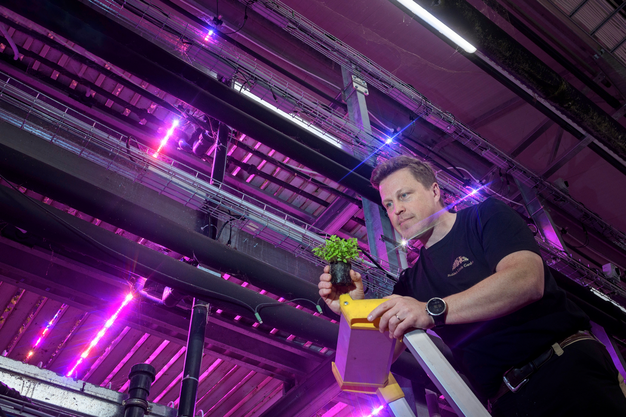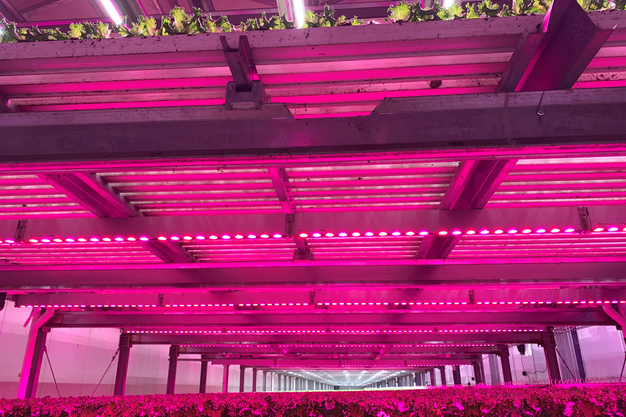In the freezing landscapes of Lapland, Finland, where extreme conditions are a constant challenge for farmers, choosing greenhouse farming or vertical farming becomes a trickier decision day by day. "Vertical farms provide a reliable environment for steady production, especially during temperature fluctuations. As well as the constant production, especially in lettuce propagation," says Robert Jordas, Founder and CEO of Robbe's Little Garden, a greenhouse and vertical farming operation in the rigid Lapland area.
Robbe's Little Garden is a Finnish greenhouse construction company specializing in hybrid greenhouse-vertical farming solutions, its first hybrid farm was built in 2015 and includes 500 square meters of growing space. Back in 2022, Robbe's Little Garden built a four-layered vertical farm with a footprint of 4,400 square meters.

Robert Jordas in his vertical farm (Photo credits: Meeri Utti)
Power blackouts and skyrocketing prices
However, currently, Finland is experiencing some energy issues, as two weeks ago, there was a power blackout for the entire day. Many greenhouse growers were forced to turn off lights for 12 hours due to skyrocketing energy prices. This resulted in a significant impact on vegetable production, revealing the vulnerability of traditional greenhouse farming to energy fluctuations.
Reflecting on the blackout, Robert adds, "If the lights had been on during that crisis, the losses for a large tomato or cucumber greenhouse could have reached 100- to 200.000 thousand euros in a single day. Balancing production costs with market prices during such crises requires careful decision-making." Up until now, choosing energy providers is done manually, but Robert sees opportunities in automating these processes as it's a way to constantly check the energy rates.
Because of the unstable energy prices, growers are unsure of how to meet contracts with off-takers. "If our prices will be skyrocketing again next week, we'd have to charge over 50 euros per 1kg of tomatoes. However, we have a good relationship with our customers, so we'll always find a way to balance it out. Yet, hopefully, the situation will stabilize. Otherwise, prices will have to increase somehow."

Greenhouse or vertical farms?
If energy prices are that high, would it make a difference to either grow in a greenhouse or a vertical farm? Challenging the commonly held belief that vertical farming is more energy-efficient than modern greenhouses, Robert asserts, "Contrary to popular belief, in Finland, my vertical farm uses around 40% more energy per square meter compared to a greenhouse. This underscores the need to compare the right variables and not fall into the trap of comparing apples with pears." However, it's purely about mathematics.
Despite the energy efficiency debate, Robert sees a place for vertical farming in specific scenarios. He says, "Vertical farming can be advantageous where land is expensive, the climate is challenging, or if there is a demand for consistent production. We need to be open-minded and transparent in our approach to find the best path forward for sustainable food production for the benefit of the entire industry."
Retail partnerships
Acknowledging the positive impact of vertical farming startups on the greenhouse industry, Robert envisions future collaborations between retailers and farmers. He states, "Direct partnerships between farmers and supermarket chains will become more prevalent, reducing the need for intermediaries. While it's uncertain if vertical farms will be in every shop, regional factors will influence the adoption of different farming technologies."

For more information:
Robbe's Little Garden
Robert Jordas, Owner
robert.jordas@robbes.fi
www.robbeslittlegarden.com
